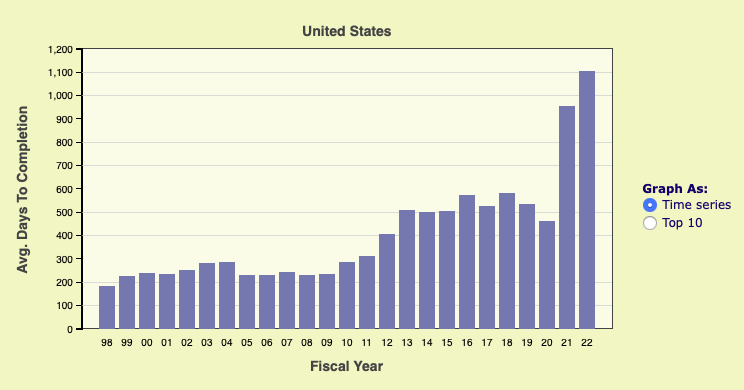The southern border is about to explode, and federal authorities are making preparations — not to arrest, detain, and deport record numbers of illegal border-crossers, but to process them quickly and release them into the United States.
How do we know? Two developments in recent days have revealed the White House’s scheme to handle the busiest time of year on the southwest border amid a record-breaking streak of illegal immigration.
Last Friday, the Centers for Disease Control and Prevention announced it will rescind Title 42 effective May 23. Title 42 is the public health order invoked by President Trump during the Covid-19 lockdowns and partially continued under President Biden. It’s one of the only reasons illegal immigration, which hit record levels last year, wasn’t much worse than it could have been. It was, in effect, the last remaining tool federal border officials had to control illegal immigration, and next month it will be gone.
By making it relatively easy for border officials to expel illegal border-crossers without processing them for deportation, Title 42 helped avert a full-blown humanitarian catastrophe at the border. For the past two years, Border Patrol agents and U.S. Customs and Border Protection officers were empowered simply to send certain classes of illegal immigrants (mostly single adults and some family units) back over the border to Mexico.
Ending Title 42 means a return to the pre-Covid process, which allows almost anyone who crosses the border, even those who cross illegally, to file a claim for asylum. Because Biden effectively shut down a Trump-era program called the Migrant Protection Protocols (also called Remain in Mexico) that forced migrants to wait in Mexico while their asylum cases were adjudicated, most migrants who claim asylum will be released into the United States pending the outcome of their cases, which on average take about three years.
In other words, ending Title 42 under these circumstances means every migrant who gets over the border and claims asylum will get to remain in the United States, legally and with work authorization, for years. As a matter of policy, it is effectively indistinguishable from open borders.
The Biden administration doesn’t want the American people to know this, to understand the details and what it means for the country. Uncontrolled illegal immigration is after all extremely unpopular, even among Democrat voters.
That’s why the administration is trying to portray what amounts to a de facto open borders policy as border enforcement and security. CBP Commissioner Chris Magnus this week issued a statement designed to do just that, but if you read between the lines you’ll see that CBP’s plan for the end of Title 42 amounts to an abdication of border security and acquiescence to open borders. Says Magnus:
Throughout our agency’s history we have capably managed immigration at the border utilizing the authorities under Title 8 of the US Code (traditional immigration management authorities). These authorities allow non-citizens appropriate access to make asylum claims and include a range of enforcement options to hold individuals accountable for entering the U.S. illegally. This means most individuals who cross the border without legal authorization will be promptly placed in removal proceedings.
As a result of the CDC’s termination of its Title 42 public health order, we will likely face an increase in encounters above the current high levels. There are a significant number of individuals who were unable to access the asylum system for the past two years, and who may decide that now is the time to come.
There’s a lot to unpack here, but note the last sentence about migrants being “unable to access the asylum system.” The implication is that if illegal immigration surges, it’s because of pent-up demand for asylum, not because Biden’s policies encouraged illegal immigration.
But that argument makes no sense given the record numbers of arrests at the southwest border since Biden came into office. Those include more than 2 million last year, an all-time record since CBP began tracking border apprehensions decades ago. Whatever pent-up demand there was has been met, and what we’re seeing now is increased demand driven almost entirely by Biden’s policies.
If illegal crossings surge in the coming months, as everyone expects them to, it’s because of what Magnus says at the end of that first quoted paragraph above: “most individuals who cross the border without legal authorization will be promptly placed in removal proceedings.”
Most Americans might think a term like “removal proceedings” means timely deportation of an illegal immigrant, but it doesn’t. Given the backlog in our immigration courts, removal proceedings amount to a legal backdoor into the United States.
The University of Syracuse keeps an ongoing tally of federal immigration data through a research center called the Transactional Records Access Clearinghouse, or TRAC. According to TRAC, out of 11,664 completed immigration court proceedings so far this year, the average time to completion is 1,105 days, or more than three years. (That’s more than double the amount of time on average it took to adjudicate cases during the Trump presidency.)

by Removals, Voluntary Departures, Terminations, Relief, Administrative Closures
In practice, that means a migrant who crosses the border illegally, gets arrested by Border Patrol, claims asylum, and is then released into the United States with a court date will have about three years to live and work in the United States before an immigration judge ever issues an order for removal.
Given Magnus’s emphasis on “removal proceedings,” then, it appears the entire federal immigration enforcement apparatus in the coming months will be focused on processing and releasing into the United States as many migrants as possible as fast as possible.
Indeed, in a long list of bullet points outlining everything CBP is doing to prepare, we see things like, “Shifting Border Patrol agents and CBP officers from other locations to assist at the border… Increasing the number of ICE personnel working alongside CBP personnel to assist in processing migrants… Activating other DHS personnel who have volunteered to temporarily work on the border… Maximizing the use of air and ground transportation to move migrants from sectors that are over capacity.”
In other words, it’s all hands on deck for the federal immigration bureaucracy, but the urgent task is to process and transport and release migrants, not arrest, detain, and deport them.
We also see, further down Magnus’s list, a plan to increase the “efficiency” of the asylum system “by restarting normal asylum-seeker processing at ports of entry and working with other DHS partners to decrease the length of these processes (this is being done, in part, by adopting a new rule to expedite processing by asylum officers).”
Last month, the Biden administration announced a sweeping new rule that will allow asylum officers at U.S. Citizenship and Immigration Services to adjudicate asylum claims instead of immigration judges at the Justice Department. The idea behind the new rule is to ease pressure on overburdened immigration courts, but as Andrew Arthur and Robert Law of the Center for Immigration Studies noted recently, it’s really “a plan to rubberstamp asylum grants and hide the disaster at the Southwest border by turning ‘illegal aliens’ into ‘asylum seekers’ with the stroke of a pen.”
As Arthur and Law explain:
Under law prior to this most recent announcement, only IJs [immigration judges] could grant asylum to aliens apprehended at the border who were then placed into ‘expedited removal’ proceedings, and then only at the end of formal removal proceedings.
In those proceedings, the alien respondent was allowed to present evidence (including testimony) concerning his or her asylum claim. During that presentation of evidence, an ICE attorney representing the interests of the American people was allowed to cross-examine and impeach the alien respondent, offer contradictory evidence, and appeal an erroneous asylum grant.
Under the administration’s new rule… those procedural safeguards are thrown out the window. The AO [asylum officer] elicits the alien’s claim during a ‘non-adversarial’ interview during which the alien is allowed to have an attorney (but you, the American people, aren’t). If the AO grants asylum, even contrary to law, logic, and the weight of the evidence, that’s it. There is no ICE lawyer to appeal that decision.
Yet CBP’s plans for the coming surge at the border, however misguided they are, might be irrelevant long before Title 42 ends on May 23. The sheer number of illegal immigrants coming across the border might well overwhelm CBP officers and facilities, even with extra help from ICE and DHS.
Already, the number of arrests at the border has forced mass releases of adult migrants. Bill Melugin of Fox News has been documenting these so-called “parole releases” in south Texas for weeks now, reporting that hundreds of migrants are being released in border towns like Brownsville every day.
They are being released, in most cases, with a notice to report to a local ICE office whenever they get to where they’re going. In some cases, they are being given phones to communicate with ICE. This means they don’t even have court dates, and have not even filed asylum claims.
In other words, the system is overwhelmed right now, with Title 42 still in place. Between now and the end of May, things are going to get much worse.









